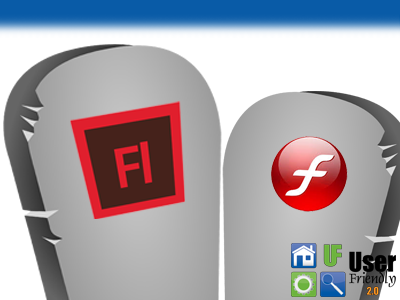By User Friendly 2.0
Adobe Flash is Dead
By: William Sikkens
Host, User Friendly 2.0 Saturday’s at 5:00 p.m.
Flash, once a standard for video and graphics online was turned off permanently yesterday. It has quite a history during its lifetime on the web.
FutureWave
Flash is based on a precursor called SmartSketch in 1993 for PenPoint OS. Haven’t heard of that? Don’t worry, unless you were working in niche operating systems in 1993 you probably haven’t. After PenPoint OS failed in the marketplace, SmartSketch was ported to Microsoft Windows and Mac OS.
As the Internet became more popular, FutureWave realized the potential for a vector-based web animation tool that might challenge Macromedia Shockwave technology. In 1995 FutureWave modified SmartSketch by adding frame-by-frame animation features and released this new product as FutureSplash Animator on Macintosh and PC.
FutureWave approached Adobe Systems with an offer to sell them FutureSplash in 1995, but Adobe turned down the offer at that time. Microsoft wanted to create an “online TV network” (MSN 2.0) and adopted FutureSplash animated content as a central part of it. Disney Online used FutureSplash animations for their subscription-based service Disney’s Daily Blast. Fox Broadcasting Company launched The Simpsons using FutureSplash.
Macromedia
In November 1996 FutureSplash was acquired by Macromedia, and Macromedia re-branded and released FutureSplash Animator as Macromedia Flash 1.0. Flash was a two-part system; a graphics and animation editor known as Macromedia Flash and a player known as Macromedia Flash Player.
FutureSplash Animator was an animation tool originally developed for pen-based computing devices. Due to the small size of the FutureSplash Viewer, it was particularly suited for download on the Web. Macromedia distributed Flash Player as a free browser plugin in order to quickly gain market share. By 2005, more computers worldwide had Flash Player installed than any other Web media format including Java, QuickTime, RealNetworks, and Windows Media Player.
Macromedia upgraded the Flash system between 1996 and 1999 adding MovieClips, Actions (the precursor to ActionScript), Alpha transparency, and other features. As Flash matured Macromedia’s focus shifted from marketing it as a graphics and media tool to promoting it as a Web application platform by adding scripting and data access capabilities to the player while attempting to retain its small footprint.
In 2000 the first major version of ActionScript was developed and released with Flash 5. Actionscript 2.0 was released with Flash MX 2004 and supported object-oriented programming, improved UI components, and other programming features. The last version of Flash released by Macromedia was Flash 8, which focused on graphical upgrades such as filters (blur, drop shadow, etc.), blend modes (similar to Adobe Photoshop), and advanced features for FLV video.
Adobe
Macromedia was acquired by Adobe Systems on December 3, 2005 which was the entire Macromedia product line including Flash, Dreamweaver, Director/Shockwave, Fireworks (which has since been discontinued), and Authorware.
In 2007 Adobe’s first version release was Adobe Flash CS3 Professional which was the ninth major version of Flash. It introduced the ActionScript 3.0 programming language that supported modern programming practices and enabled business applications to be developed with Flash. Adobe Flex Builder (built on Eclipse) targeted the enterprise application development market and was also released the same year. Flex Builder included the Flex SDK, which had a set of components that included charting, advanced UI, and data services (Flex Data Services).
In 2008 Adobe released the tenth version of Flash, Adobe Flash CS4. Flash 10 improved animation capabilities within the Flash editor adding a motion editor panel (similar to Adobe After Effects), inverse kinematics (bones), basic 3D object animation, object-based animation, and other text and graphics features. Flash Player 10 included an in-built 3D engine (without GPU acceleration) that allowed basic object transformations in 3D space (position, rotation, scaling).
Also in 2008, Adobe released the first version of Adobe Integrated Runtime (later re-branded as Adobe AIR), a runtime engine that replaced Flash Player, and provided additional capabilities to the ActionScript 3.0 language to build desktop and mobile applications. With AIR developers could access the file system (the user’s files and folders) and connected devices such as a joystick, gamepad, and sensors for the first time.
In 2011 Adobe Flash Player 11 was released with the first version of Stage3D allowing GPU-accelerated 3D rendering for Flash applications and games on desktop platforms such as Microsoft Windows and Mac OS X. Adobe further improved 3D capabilities from 2011 to 2013 adding support for 3D rendering on Android and iOS platforms, alpha-channels, compressed textures, texture atlases, and other features. Adobe AIR was upgraded to support 64-bit computers and to allow developers to add additional functionality to the AIR runtime using AIR Native Extensions (ANE).
In 2014 Adobe AIR reached a milestone with over 100,000 unique applications built and over 1 billion installations logged across the world (May 2014). Adobe AIR was voted the Best Mobile Application Development product at the Consumer Electronics Show for two consecutive years (CES 2014 and CES 2015). In 2016 Adobe renamed Flash Professional, the primary authoring software for Flash content, to Adobe Animate to reflect its growing use for authoring HTML5 content in favor of Flash content.
End of Flash
One of Flash’s primary uses on the Internet when it was first released was for building fully immersive interactive websites. These were typically highly creative site designs that provided more flexibility over what the current HTML standards could provide as well as operate over dial-up connections. However, these sites limited accessibility by “breaking the Back Button” dumping visitors out of the Flash experience entirely by returning them to whatever page they had been on prior to first arriving at the site. They were furthermore seen as a form of elitism as they typically required paying a design firm to create and maintain the site compared to those that could be developed in HTML. Fully Flash-run sites fell out of favor for more strategic use of Flash plugins for video and other interactive features among standard HTML conventions along with the availability of HTML features like cascading style-sheets in the mid-00’s. At the same time this also led to Flash being used for new apps, video games, and animations. Precursors to YouTube but featuring user-generated Flash animations and games such as Newgrounds became popular destinations further helping to spread the use of Flash.
Toward the end of the millennium, smartphones with browsing capabilities were released due to the development of Dynamic HTML. Fifteen years later WAP had largely been replaced by full-capability implementations and the HTML5 standard that included more support for interactive and video elements. Support for Flash in these mobile browsers was not included. Apple’s Steve Jobs famously wrote an open letter to Adobe in 2010 criticizing the closed nature of the Flash platform and the inherent security problems with the application to explain why Flash was not supported on iOS. Adobe created the Adobe AIR environment as a means to appease Apple’s concerns and spent time legally fighting Apple over terms of its App Store to allow AIR to be used on the iOS. While Adobe eventually won, allowing for other third-party development environments to get access to the iOS, Apple’s decision to block Flash itself was considered the “death blow” to the Flash application.
In 2015, Adobe rebranded its Flash authoring environment as Adobe Animate to emphasize its expanded support for HTML5 authoring and stated that it would “encourage content creators to build with new web standards” rather than using Flash. In July 2017 Adobe announced that it would declare Flash to be End-Of-Life (EOL) at the end of 2020. They would cease support, distribution, and security updates for Flash Player. After the announcement developers started a petition to turn Flash into an open-source project leading to controversy.
The Flash Platform will continue in the form of Adobe AIR, which Adobe will continue to develop with OpenFL, a multi-target open-source implementation of the Flash API. Additionally, Adobe Animate will continue to be developed by Adobe even after 2020.
Starting from Chrome 76 and Firefox 85, Flash is disabled by default and browsers do not even show a prompt to activate Flash content. Users who want to play Flash content need to manually set a browser to prompt for Flash content and then during each browser session enable Flash plugin for every site individually. Furthermore, browsers will show warnings about the removal of Flash entirely after December 2020. Microsoft Edge based on Chromium will follow the same plan as Google Chrome.
Google Chrome will block the Flash plugin as “out of date” in January 2021 and eventually remove it from the source code. Also in December 2020 Flash support will be completely removed from Firefox. Apple dropped Flash Player support from Safari 14 alongside the release of macOS Big Sur. In a move to further reduce the number of Flash Player installations, Adobe announced plans to add a “time bomb” to Flash to disable existing installations after the EOL date to prompt users to uninstall Flash and to remove all existing download links for Flash installers. Microsoft will be removing Adobe Flash from the Windows OS entirely in January 2021 via Windows Update. In October 2020 Microsoft released a preview for the Windows 10 and 8.1 update, which removed Adobe Flash components from Internet Explorer.
Because of the creative use of Flash for websites, video games, and animations from its early days, there have been several efforts to try to preserve these works following Flash’s EOL. The Internet Archive introduced Ruffle implementation to emulate Flash games and animations without the security holes in November 2020 opening a new collection for creators and users to save and preserve Flash content. The Flashpoint project collected more than 38,000 Flash applications excluding those that were commercial products and offered a large freely available archive for users to download.
What to do next
If you still have Flash installed on your computer it’s time to remove it. On Windows, the Flash Player may be listed in your “Apps and Features” section of control panel. You can click it there and uninstall. On the Mac you may need an uninstaller. The details can be found on Adobe’s website at https://helpx.adobe.com/flash-player/kb/uninstall-flash-player-mac-os.html.
William (Bill) Sikkens has been an on-air technology expert since 2014. With an expertise in I.T., cyber security and software design he has had more than 20 years’ experience with advanced technology. Sikkens conceptualizes and designs custom applications for many professional industries from health care to banking and has the ability to explain the details in a way all can understand. Article edited by Gretchen Winkler, who along with Jeremy Winkler are the co-hosts of User Friendly 2.0 here on The Answer Saturday’s at 5:00 p.m.
Links and brand/store information provided are for information only and are not endorsed by Salem Media Group, KPAM or the shows hosts. Material for this article from Wikipedia.
Got a technology question or comment for Bill? Follow him on Twitter @sikkensw


